Istanbul — Look around, feel history
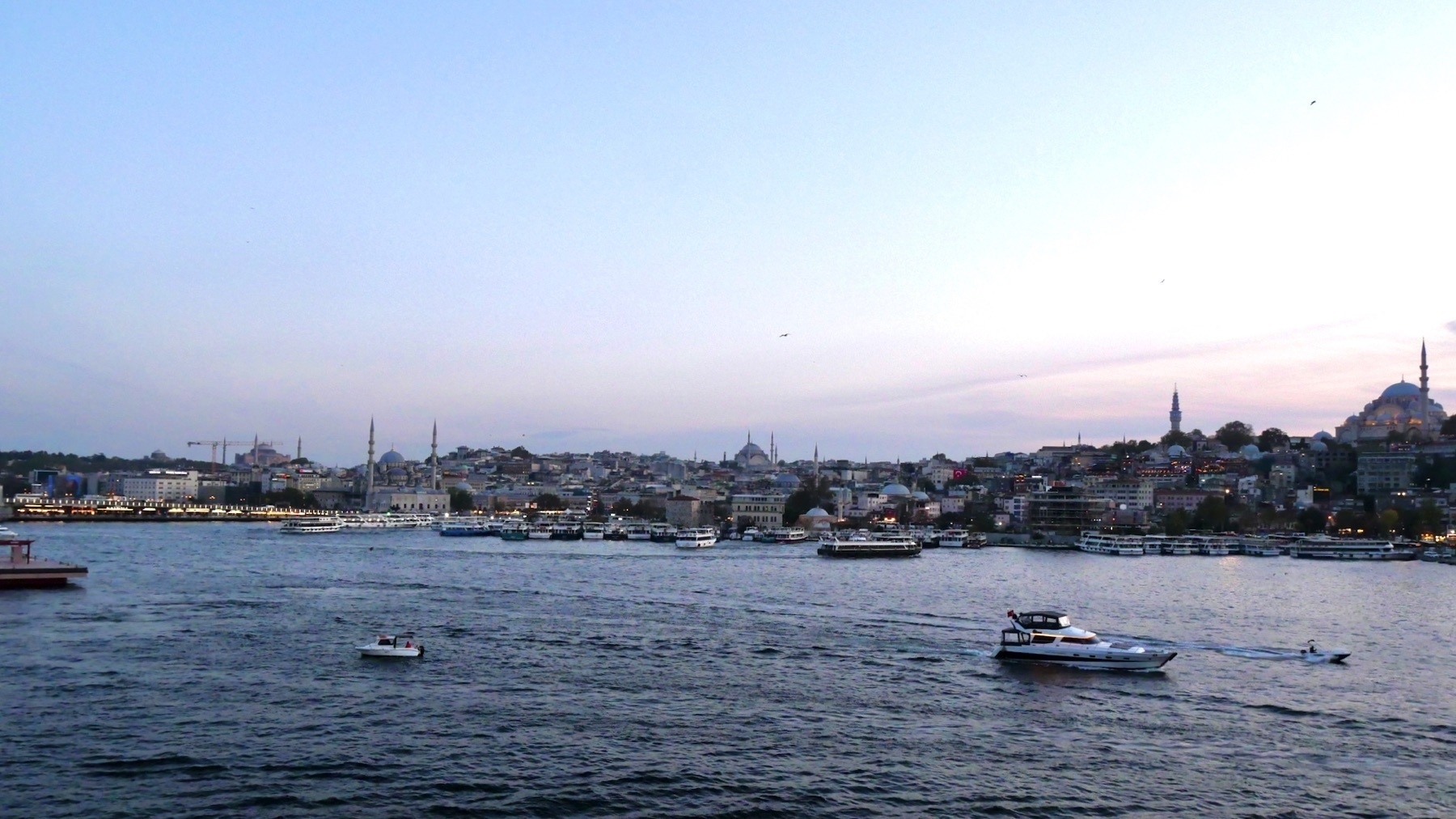
Istanbul, Constantinople, Nova Roma — the city at the crossroads of the world — is a city of layers. First settled 6000 years ago each new community was built on top of the previous. And being located at such a strategic point as the world’s only trans-continental city, there have been a lot of different people groups and empires with designs on the city.
I was in town for just over ten days, mostly for work, but my old pal Chris Gunson flew up from Dubai and we toured around together for a few days. Twenty years ago Chris and I used to talk and trade book recommendations about transcontinental history, but this was the first time we could walk old streets together (a meeting in Kazakhstan was aborted in 2004 for a bad visa, which redirected me southwards to Kashgar and the Pamir Plateau. A few pics from that trip long ago.)
This post serves as a bit of a trip report. You may want to read it while browsing the galleries of photos on Flickr, linked at the bottom of this post.
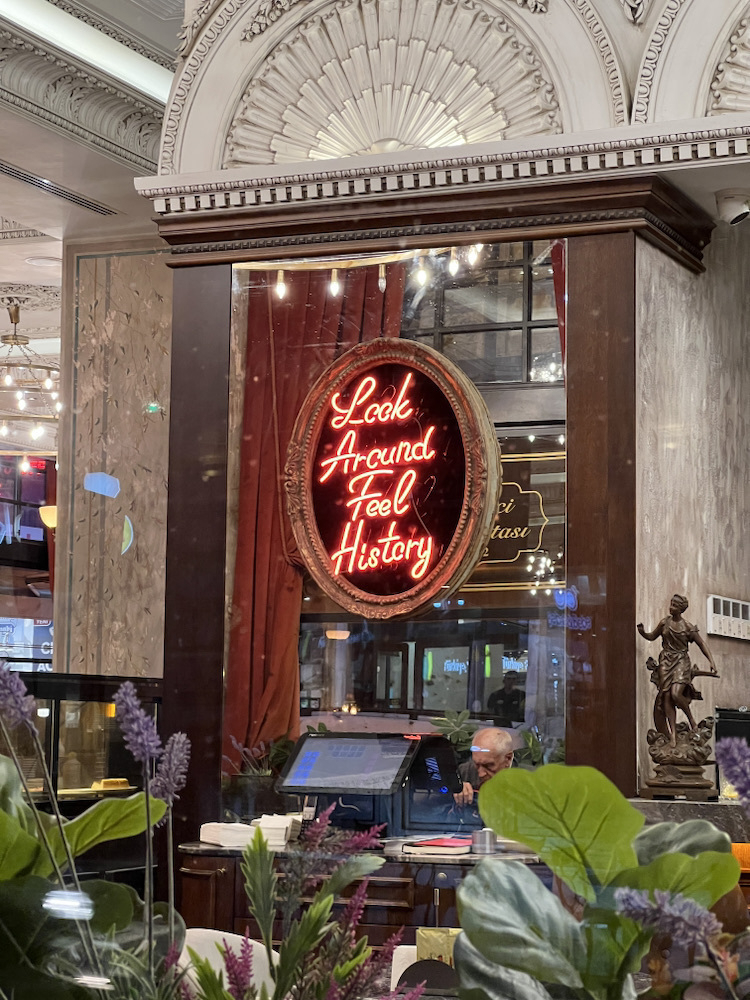
A sign through the window.
Istanbul has changed hands between the Greeks and Romans a number of times, before being conquered by the Ottomans in 1453. After so many years of Turkish rule, it is easy to forget that Istanbul was once part of “Magna Grecia”, Greater Greece, and even part of the Delian League. The old names of cities found in Thucydides and other classics are still there under Turkish localized names: Smyrna is now the seaside resort of İzmir; in 325 CE the First Council of Nicaea was held in the modern town of İznik; one afternoon we crossed the Bosporus in a small ferry to visit Kadıköy, an older area of the Asian side of Istanbul that used to be called Chalcedon, where the fourth ecumenical Christian council was held in 451 CE. This is in fact the area where archeological artifacts have been found dating back to 5500 BCE.
As Constantinople, the capital of eastern Christianity and inheritor of the Roman Empire after Rome fell and the West sunk into the Dark Ages, the city suffered many attempts at conquest by various people groups such as the Goths and Persians. It was impregnable, largely due to the massive triple city wall, first built by Constantine and then added to by King Theodoseus in the 5th Century. They held for a thousand years before finally being breached in 1453, when the Ottoman conquerers used massive cannons of Hungarian design to launch cannon balls weighing 500 kilograms into the walls. This created holes for the invaders to break through, but didn’t actually destroy the walls which still stand today. Just a short walk from the 1453 Museum, which describes the conquering of the city in very cinematic fashion, you can get right up to the walls. I saw tourists crawling up and inside. Today the wall runs alongside a freeway. From working class neighbourhoods inside the walls people drive their cars through old arched gates to access the freeway. Here and there in the green space between the walls and the freeway people have planted vegetable gardens!
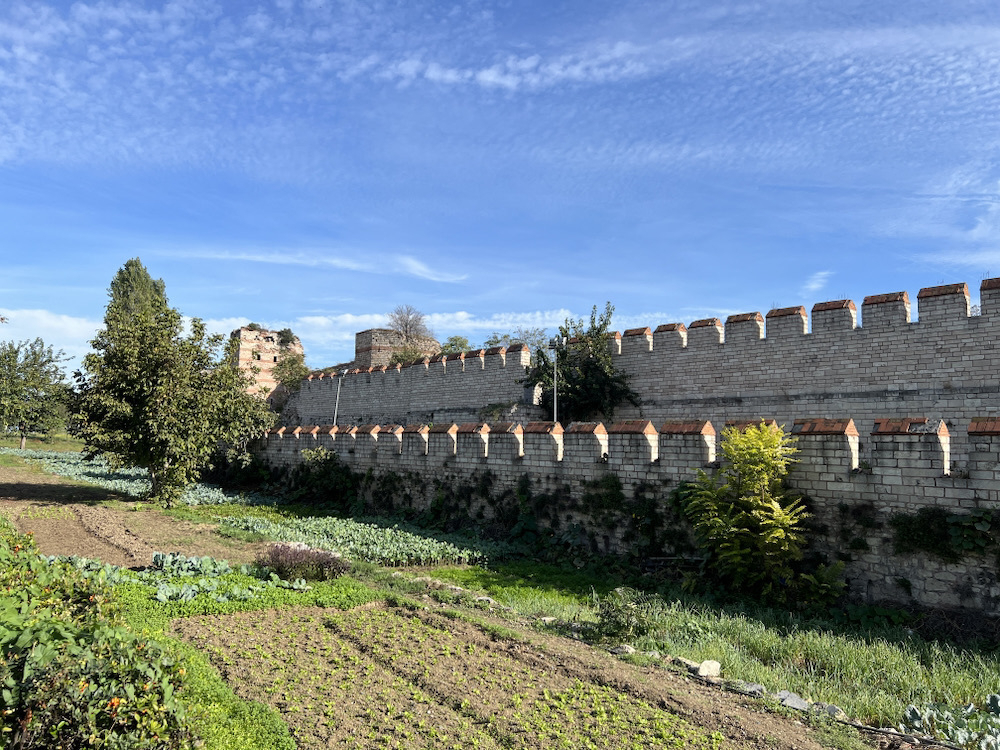
5th century walls of Theodoseus.
The Ottoman period lasted until 1923 when the Republic of Turkey was founded by Mustafa Kemal Atatürk who transformed Turkish society. Driving into the city from Istanbul Airport, the busiest airport in Europe, I immediately noticed all the Turkish flags hanging from apartment windows and strung along and across the streets. This year is the 100th anniversary of the founding. Not only that, but the day after I landed was the anniversary of Atatürk’s death, on November 10th 1938 at 9:04am. Why do I know the time? Well, while we were having breakfast at the rooftop restaurant of my hotel, with an epic view of the sunrise over the Asian side of the city, all of a sudden I could hear the horns of the ships in the harbour blasting simultaneously. I thought it was some sort of earthquake warning or air-raid siren. Looking around I noticed all the hotel restaurant staff line up and stand at attention. Not knowing what was happening I stopped eating and just waited for something to indicate what was going on. After a minute of very loud silence, the staff went back to work and the harbour continued to buzz with activity. This happens every year, and I heard from one Turkish man that back in the day drivers would stop and get out of their cars to stand by open driver doors out of respect.
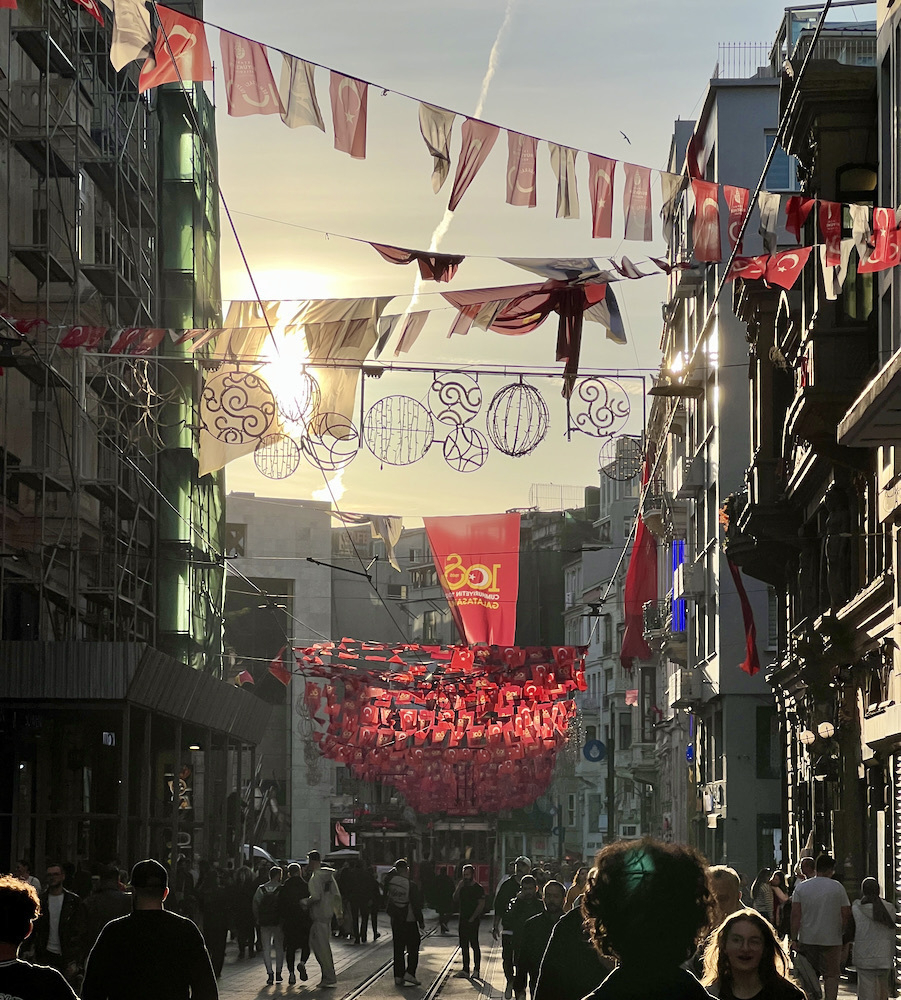
Turkish patriotism hangs above everyone’s heads.
Evidence of the 100 year anniversary are all over. Many shops have 100th Anniversary marketing displays in their windows. At Taksim Square, a large plaza in the heart of the tourist district, is a massive circular display blaring out patriotic messages featuring smiling families, guns, and fighter planes. There is a huge light show at the gigantic new mosque on the square, an initiative by the long-time President Recep Tayyip Erdoğan. Taksim Square is normally thought of as a symbol of the country’s republicanism and secularism. The new mosque, completed in 2021, is a conspicuous symbol of conservatism on Turkey’s contemporary politics.
Erdogan’s presence is easily spotted across the city. He used to be mayor of the city, but ever since the AKP got into national power and he became president, the politics of the country have slanted more conservative. Some of Erdogan’s initiatives, what he himself has called his “crazy ideas”, are large scale construction projects such as the controversial Istanbul Airport (for whom allegedly all the building and maintenance contracts went to his relations) and his giant canal proposal. Other initiatives are more on the side of promotion of Islamic culture, like the controversial Taksim Mosque. When looking across the Bosphorus Strait from my hotel, the horizon of the Asian side of Istanbul is dominated by two structures. First is the giant Çamlıca Tower, the tallest structure in Istanbul, a telecom tower with observation deck and restaurants. To the left is the Grand Çamlıca Mosque, the largest mosque in Turkey able to hold 63,000 worshippers for prayer times. This mosque was opened in 2019 and sometimes referred to in the streets as “His Mosque”. You will note that it has 6 minarets.
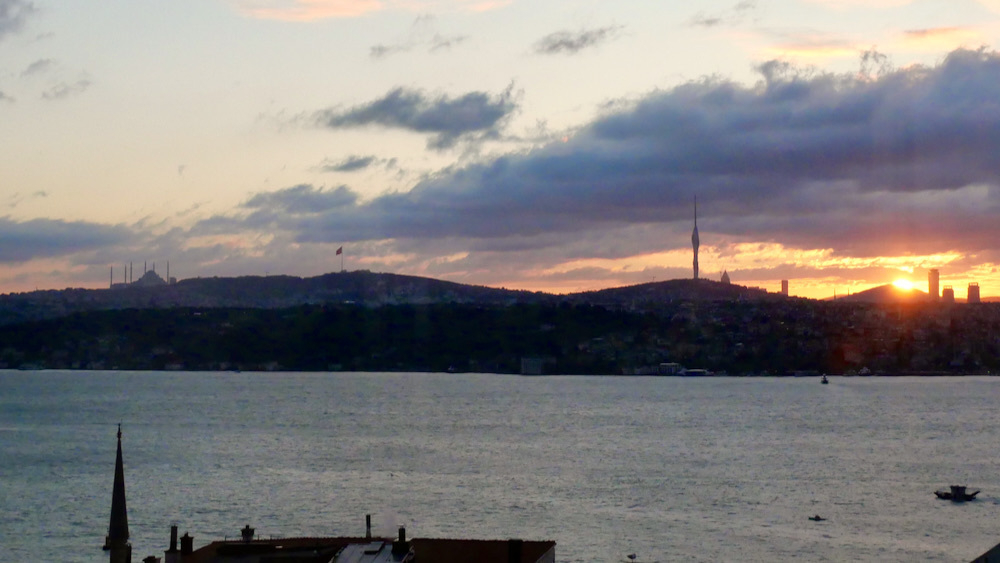
Tower to the right, mosque to left.
The only other mosque in Istanbul to have such a thing is the beautiful Blue Mosque, across the river to the south on the Golden Horn in the old city. This mosque was built in the early 17th Century by the master architect Sinan (who was obsessed with the Hagia Sophia, topic of a future post) at the direction of Sultan Ahmed I. At the time, the only other mosque with six minarets was the mosque of the Ka’aba in Mecca. When the Blue Mosque was completed people were shocked at the audacity, thinking the Sultan too proud. To resolve the situation he sponsored a seventh minaret at Mecca.
The area around the Blue Mosque is spectacular to walk around. But beware of the terrible Istanbul traffic in getting there! One time we had a taxi driver frustrated and yelling at everyone around us stop the car and get out, go five cars up to yell and someone, then came back to tell us “You walk from here.” In front of the Blue Mosque is a plaza that is built upon the old Hippodrome which is a few layers down. As the capital of Eastern Rome they people needed their bread and circuses! In ancient times the spina of the hippodrome, the long section down the middle which charioteers would race around, used to have many treasures brought from across the empire. Now only three remain: an obelisk brought from Egypt In 390 CE which dates to 1490 BCE; another obelisk of more murky past; and the remains of the Serpent Column which Constantine brought from Delphi in 324. I was very excited to see the Serpent Column, a bronze pillar cast by the Greeks in celebration of their victory against the invading Persians in the 5th century BCE. This thing is 2500 years old and just sitting outside! You can go and see it any time. Amazing!
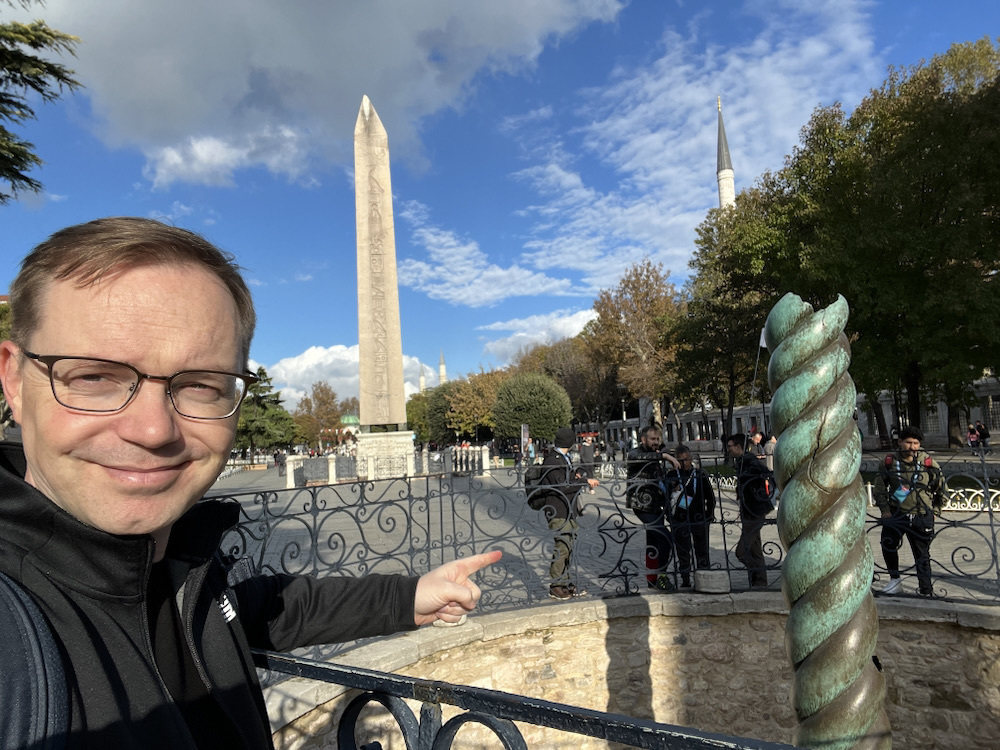
Very excited to be so close to a 2500 year old artifact!
My most favourite thing of this area is the Hagia Sophia, the cathedral originally built in the 4th C and converted to a mosque in 1453. That deserves its own post.
In cold winds and rain I wandered from the Blue Mosque and the Ayyasofia up to the Grand Bazaar, a mostly covered shopping area with over 4000 stores. Here I badly negotiated for a box of delicious Turkish Delight and a nazar pendant. I am terrible at negotiating in these situations. Though all in all I think I did pretty well and was never taken for a real ride. Once we fell for the old shoeshiner- dropped-brush-scam, but other than that, our wallets were safe.
The weather was bad for some of the days. The wind rocked our ferry crossing back from the Asian side, and one freezing morning when I went to the local Kathie Dunyasi (a kind of Turkish Starbucks) all the seats were taken by cats who came in from the cold!
Other days the sky was a gorgeous blue and we could walk the steep, narrow streets around the Galata Tower, the historic district of Genoese traders. The cobblestones and European buildings reminded me of Lisbon. I have now been to the Westernmost and Easternmost edges of Europe, but never in between. Also, both Lisbon and Istanbul are Cities with Seven Hills! I am cursed! (However, I found out later that many more cities claim this honour).
On another sunny day I was able to walk up to the Topkapi Palace, built by the Sultan and home to many treasures. The Palace is located at the tiP of the Golden Horn and affords clear views of the north part of Istanbul and the main bridge that crosses the Bosphorus to the Asian side of the city. Inside the complex we wended our way through the harem, visited the sultan’s chamber room and bath, and took in all sorts of treasures like the Topkapi Dagger, which features massive emeralds on its hilt. I first saw the Topkapi dagger in Osaka many years ago when it was on tour around the world. I was very glad to see it in its home.
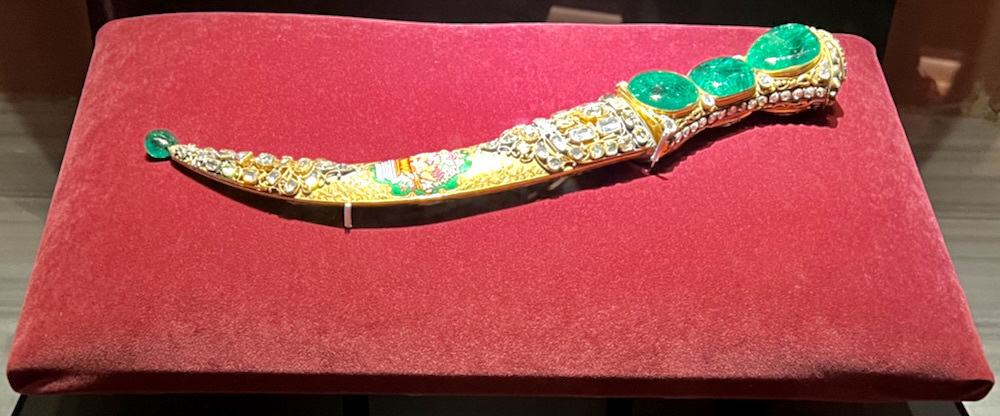
The Topkapi Dagger, in all its shiny glory.
In 1204, during the Fourth Crusade, the city was ransacked by Europeans at the behest of Rome. They destroyed much, but also stole important Christian relics like the robe of Mary and probably the Shroud of Turin. There still remain some artifacts, held in Topkapi Palace. There you can see the relics like the arm of John the Baptist, the staff of Moses, David’s sword, and a whole bunch of personal belongings of the Prophet Muhammad.
It was short, but I enjoyed walking the hills of this old city, visiting just a couple of its 3500 mosques and two of its many football stadiums. I ate well, but did not get the opportunity to enjoy a Turkish bath. Also, there are a lot of smokers, both inside and outside of restaurants, so beware! (In fact even the taxi drivers smoked like chimneys while they raced through the streets, or sat perfectly still in traffic banging on their car horns.)
In preparation for the trip I read Thomas F. Madden‘s Istanbul: City of Majesty at the Crossroads of the World which gave me just enough detail to appreciate the layers of history of the city. Also, check out the episode of Geography Now on Turkey which is lots of fun.
Photo Galleries on Flickr
- 🇹🇷 Istanbul (All Photos) 138 photos, 24 videos
- 🏛️ 1453 Museum and City Walls 7 photos, 7 videos
- 🏰 Topkapi Palace 25 photos, 4 videos
- 🕌 Hagia Sophia and surroundings 22 photos, 4 videos Also read my post on the Hagia Sophia here →